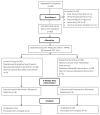Comparison of Neuromuscular Joint Facilitation and Quadriceps Strengthening Exercise in Knee Osteoarthritis: a Randomized Controlled Trial
- PMID: 37662633
- PMCID: PMC10442219
- DOI: 10.3822/ijtmb.v16i3.811
Comparison of Neuromuscular Joint Facilitation and Quadriceps Strengthening Exercise in Knee Osteoarthritis: a Randomized Controlled Trial
Abstract
Objectives: To compare the effect of neuromuscular joint facilitation (NJF) and quadriceps strengthening exercises on pain, physical function, static posture, and balance control in subjects with knee osteoarthritis.
Design: Randomized controlled trial.
Setting: Department of Physiotherapy, Manipal Hospitals, Bangalore.
Participants: Subjects diagnosed with knee osteoarthritis according to the American College of Sports Medicine criteria. The mean age of subjects in the control group was 63.12 ± 8.08 years; in the experimental group was 61.77 ± 8.46 years.
Interventions: The intervention group received NJF treatment twice a week for six weeks, and the control group received quadriceps strengthening exercises. Standard knee exercises were given as a home program to both groups.
Outcome measures: Numeric Pain Rating Scale (NPRS), 30-second chair stand (30s-CST), and single leg stance (SLS) were used to assess physical function, static posture, and balance control, respectively, at the end of the sixth week.
Results: Sixty subjects were randomly allocated to intervention and control groups. The experimental and control group showed a mean difference of 3.89 and 4.17 in NPRS, 4.19 and 4.17 in 30s-CST, 6.81 and 5.71 in SLS at the end of six weeks. This change was significant within both groups (p value .000) and not significant between groups (NPRS p value .303; 30s-CST p value .09; SLS p value .525) at the end of six weeks.
Conclusions: NJF and quadriceps strengthening exercises effectively reduced pain and improved physical function, static posture, and balance control in subjects with knee osteoarthritis. Both groups had the same effect on all clinical variables at six weeks of follow-up. Hence, further studies with long term follow-up are warranted.
Keywords: knee osteoarthritis; neuromuscular exercise; physical therapy; quadriceps.
Copyright© The Author(s) 2023. Published by the Massage Therapy Foundation.
Conflict of interest statement
CONFLICT OF INTEREST NOTIFICATION The authors declare there are no conflicts of interest.
References
-
- Jordan KM, Arden NK, Doherty M, Bannwarth B, Bijlsma JW, Dieppe P, et al. EULAR Recommendations 2003: an evidence based approach to the management of knee osteoarthritis: report of a Task Force of the Standing Committee for International Clinical Studies Including Therapeutic Trials (ESCISIT) Ann Rheum Dis 20036212:1145–1155.10.1136/ard.2003.011742 - DOI - PMC - PubMed
-
- Mahajan A, Verma S, Tandon V. Osteoarthritis. J Assoc Physicians India. 2005;53:634–641. - PubMed
-
- Ajit NE, Nandish B, Fernandes RJ, Roga G, Kasthuri A. Prevalence of knee osteoarthritis in rural areas of Bangalore urban district. Internet J Rheumatol Clin Immunol. 2013;1(S1):1–8.
LinkOut - more resources
Full Text Sources

